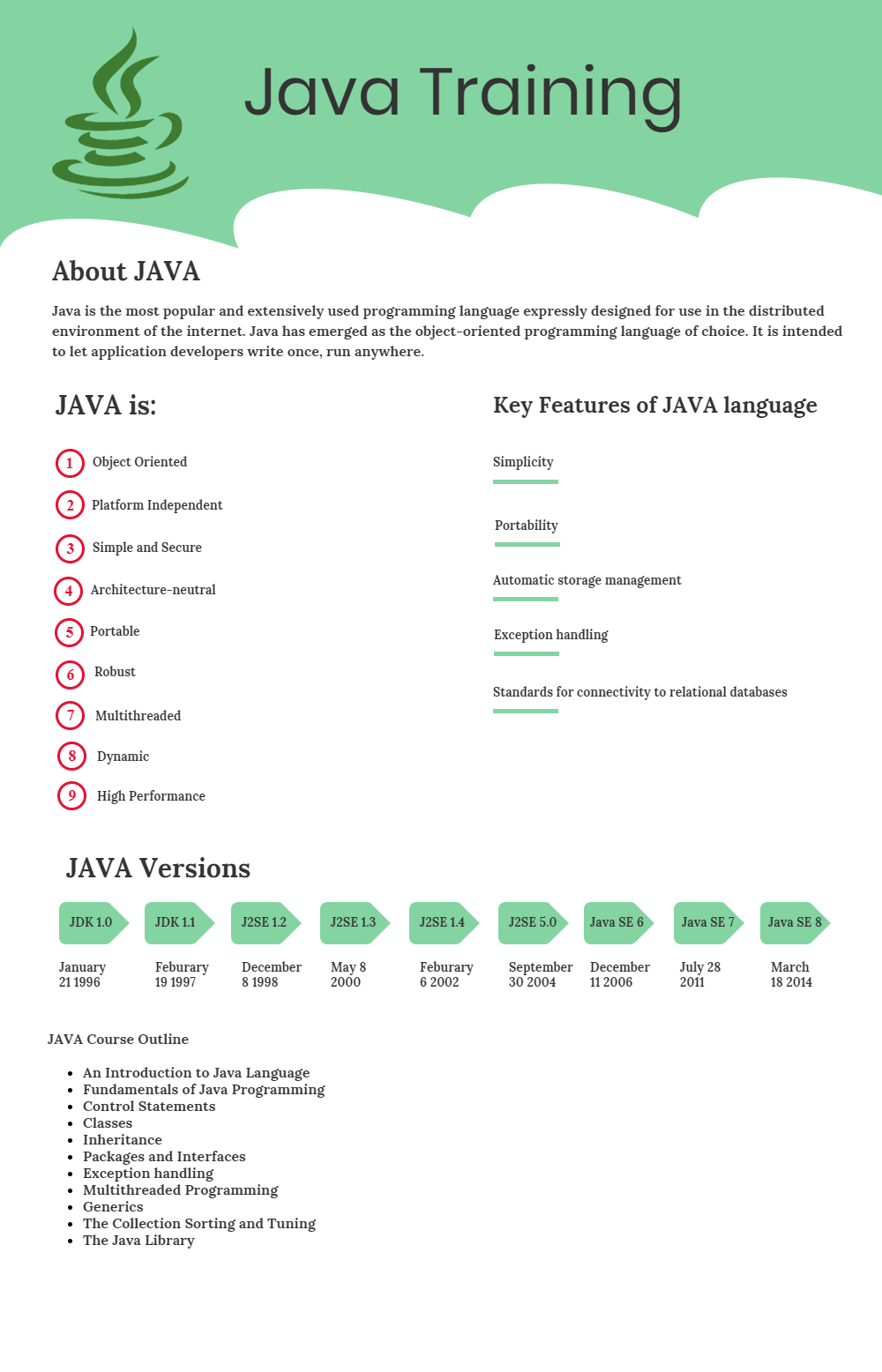An Introduction to Java Language
The module provides the knowledge about Java language and description of the object-oriented concepts and abstraction concepts.
- Brief History of Java
- Evaluation of tools
- Describe object-oriented programming
- Key Features of object-oriented programming (OOP)
- The three principle of OOP
- Analysis of abstraction
Fundamentals of Java Programming
The module covers the study of basic building blocks of programming language such as data types, variables, basic types and operators
- Describe Data Types, Variables and Arrays
- Examine Operators and Control Statements
- Using Primitive Types
- Explain control statements
- Overview of Arrays
- Different types of operators
- Applying Arithmetic and Bitwise operators
- Understanding operator precedence
Control Statements
The module explains the various kinds of statements used such as selection, iteration, and jump statements.
- Selection statements
- If
- If-Else
- Nested If-Else
- Jump statements
- Using Break
- Using Continue
- Return Statements
- Iteration statements
- While loop
- Do-while loop
- For loop
Classes
This section includes the knowledge of classes, objects, constructors, and destructors.
- Understand class
- Declaration of objects
- Define Introducing Methods
- Understand concept of constructors and destructors
- Use of This Keyword
- Describe The finalise () method
- Explain various access modifiers
- Overloading of methods
Inheritance
The module explains various types of inheritances and various concepts used within this.
- Overview of inheritance
- Usage of super keyword
- Calling of constructors
- Using final keyword with inheritance
Packages and Interfaces
The module helps the delegates in understanding the Collection of classes and methods.
- Overview of packages
- Importing of packages
- Explain interfaces
Exception handling
The module covers the handling of exceptions generated by code.
- An introduction to exception handling
- Describe types of exceptions
- Using try and catch
- Describe Nested try statements
- Use of exceptions
Multithreaded Programming
During the module, the delegates will gain an understanding of threading concepts, thread priorities and stages of the model.
- An introduction to Java thread model
- Creating threads and multiple threads
- Understanding thread priorities
- Describe Suspending, Resuming and stopping threads
I/O and Applets
The module explains about input and output streams.
- An introduction to I/O
- Describe Reading and writing console inputs
- Describe Applets
- Understand Calling overloaded constructors through this()
Generics
During the module, the delegate will learn how to use the operating data on as a parameterized type.
- An introduction to Generics
- Explain Generics example
- Creation of Generic methods
- Describe the Generic interfaces
- Explain Generic class hierarchies
The Collection classes
The module explains the all set of framework classes.
- Describe the Collections Framework
- Set Implementation Classes
- Describe Set, Map, Queue and List Interface
- List Implementation Classes
- Queue Implementation Classes
- Map Implementation Classes
The Collection Sorting and Tuning
The course explains how to use storage structures.
- Sorting with Comparable and Comparator
- Explain Sorting Lists and Arrays
- Methods of Collections Utility
- Understand Tuning ArrayList, HashMap, and HashSet
Java EE Overview
The course explains the fundamental concepts of Java EE framework.
- An introduction to Java EE
- Describe Java SE Building Blocks
- Web Applications and Services
- Describe Enterprise JavaBeans
- Extra J2EE APIs
- Explain POJO, Dependency Injection, and Annotations
- Describe the platform of Java EE
Eclipse
The course will explain how to use Eclipse for writing Java code.
- An introduction to Eclipse
- Installing Eclipse
- Running Eclipse
- Describe Editors, Views, and Perspectives
- Setting up a Project
- Generating a New Java Application
- Running a Java Application
- Debugging of a Java Application
- Importing Java Code into Eclipse
The Java Library
The module includes set of all libraries and event handling.
- An introduction to string handling
- Describe Java. Lang package
- Input/Output: Exploring java.io
- Using Networking
- Evaluate Applet Class
- Understand the concept of Event Handling
- Describing the AWT: Working with Windows, Graphics, and Text
- Using AWT Controls, Layout Managers, and Menus
- Describe Concurrency Utilities





